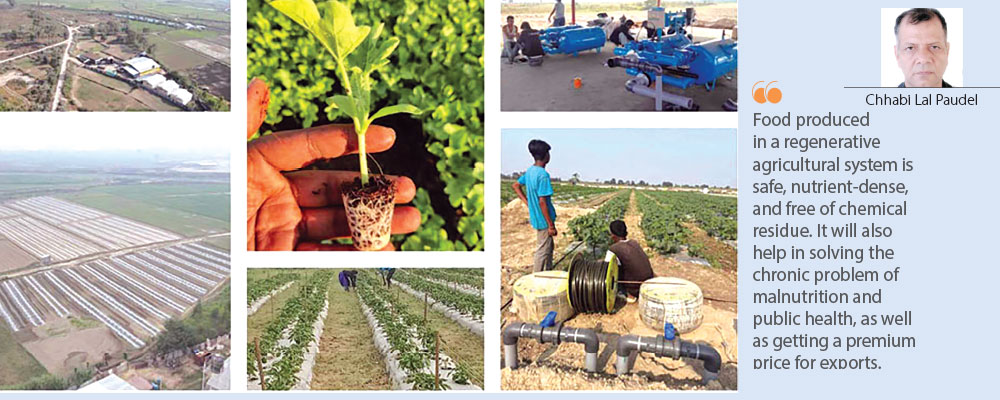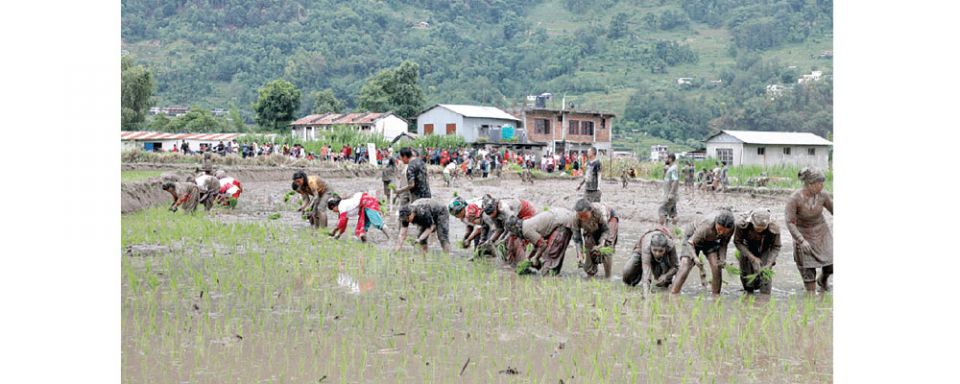
Nepali agriculture is not taking pace due to climate change, degradation of soil fertility, soil erosion, a lack of organic matter in the soil, haphazard use of agrochemicals, and an increase in human population and urbanisation. The total cultivated land of the country is 3,091,000 hectares, which covers 21 per cent of the total area of the country. Around 15 to 20 per cent of the cultivated land is fallow due to the migration of rural people.
Regenerative solutions
Regenerative agriculture focuses on improving soil health, biodiversity, ecosystem services, carbon sequestration, and sustainable rural livelihood. Selecting suitable crops for managing adverse environmental conditions is crucial for sustainability. Regenerative agriculture sustainably manages natural resources for productivity enhancement and rural livelihood support. Our sloping land terraces are collapsing from landslides, river basin tars are washed by increased river flow, and the Tarai plain is inundated by floods, which have adverse effects on food security and rural livelihoods. Small household farmers are not only food producers but also the custodians of natural resources, which are the major base of food production. They protect forests, soil, water, and biodiversity.
Globally, small household farmers occupy only 30 per cent of the cultivated area and are able to feed 75 per cent population of the world. Therefore, Nepal should give priority to family farmers for food, nutrition, and environmental security.
Regenerative agriculture could be an alternative solution for climate change, soil degradation, and rural livelihood enhancement. It includes the concepts of natural farming, organic farming, and low-input agriculture. Revival of agriculture-related natural resources and developing rural economies is possible by means of regenerative agriculture. Food, nutrition, and environmental security are possible through regenerative agriculture supported by national policy. The subsidy given for synthetic chemicals has discouraged farmers from collecting forest leaf litter, which has increased the incidence of forest fires. Farmers should get subsidies for increasing organic matter content in their farmland, which makes farming productive, sustainable, and regenerative.
The new constitution of Nepal has recognised food security and food sovereignty, which are possible through regenerative agriculture. Research priorities should be on agroecology, harnessing natural principles of ecosystems, natural means of productivity enhancement, and resource conservation. There should be a proper balance between the conventional anthropocentric approach and the new regenerative eco-centric approach in the new agriculture development policy. The agro-ecological diversity and cultural diversity of the country provide good scope for the development of regenerative agriculture. Food security and economic prosperity can be achieved by regenerative, sustainable agriculture, as targeted in the UN Sustainable Development Goals.
Agrochemical impacts
The organic matter content of the soil of Tarai, which is the main grain basket of Nepal, is very low, and the land productivity has drastically decreased, resulting in skyrocketing food imports. A food-exporting country has turned into a major food importer due to the loss of inherent soil productivity. Soil fertility is decreasing and soil acidification is increasing due to the continuous application of chemical fertilisers. The immune power of crop plants to resist insect and disease attacks has been reduced due to the overuse of chemical fertilisers and pesticides. The population of honey bees and other pollinator species has reduced due to the application of pesticides. Food products laced with high agrochemicals are imported and freely distributed to consumers without any check or quality control. This is worsening the public health situation in the country. Multinational companies are pushing hazardous synthetic agrochemicals and hybrid seeds through agrovets in the country. Agrovets is trying to push this due to high profit margins and commissions from those companies. This has resulted in a natural imbalance, and the population of predators and parasites is reduced, resulting in more pest resurgence and productivity loss. The population of natural pollinators has declined, and the crop yield of the cross-pollinated species has gone down. There is a drastic yield reduction in rapeseed in Banke, Dang, Bardiya, Kailali, Kanchanpur, and many other parts of the country due to the loss of the Simal tree (Bombax species), which is the habitat of the seasonal migrant wild bees (Bhir Mahuri). The honey bee is the key species for natural pollination in rapeseed, mustard, buckwheat crops, and many other cross-pollinated plant species.
Integrated farming
The crop-livestock integrated farming system of the mountains, river basins, hill terraces, and valley bottoms is facing many problems. Crops are destroyed by monkeys and other wild animals. The other constraints of farming are water scarcity, soil erosion and fertility decline, the unavailability of fodder grasses and leaf litter, labour unavailability, and the feminization of agriculture. Natural pasture land has degraded due to the infestation of non-native, invasive, and exotic species like Banmara (Euporatium) and Parthenium. Massive plantations of pine trees (pinus species) are also one cause of the decline in forage diversity and the low availability of palatable species for wild animals and domesticated herds. So monkeys are unable to get edible things in the forest and have shifted to farm communities in search of food. The traditional nutrient cycling rate from forest to cropland through animal grazing is reduced. The number of livestock has declined due to the reduced availability of forage and fodder. As a result, crop productivity as well as livestock productivity have reduced, and there is an acute shortage of food. The mountains and hills are rocky and suitable for wild animal habitat. The large human population has migrated, creating a positive condition for wild animals to flourish and multiply.

Nepal is the fourth-most vulnerable country in the world to the impact of climate change, although it is not a contributor to climate change due to its very low emissions. Washing of the river basin productive tars, landslides in the hill terraces, and flooding and inundation in Tarai and inner Tarai lowland areas are the big disasters increasing day by day. Droughts, floods, forest fires, cold waves, and heat waves are the climatic problems faced by Nepal. The mountain area is facing a drought problem due to the fast melting of snow with the increase in temperatures. The uneven climatic events are dangerous for farming and cause loss and damage to property. The agriculture sector is biological in nature and hardest hit by uneven climatic events. The agricultural crop calendar has been disturbed, and untimely rain is also destroying crops in the maturity and harvesting stages. Resilient and regenerative agriculture systems could be a solution here.
Regenerative agriculture includes indigenous knowledge, modern science, successful practices, and movements to produce sufficient food, conserve nature, and address issues of equity and inclusiveness. It avoids conventionally used harmful synthetic agrochemicals, antibiotics, hormones, and food additives. Natural, ecological, and ecosystem principles are applied in farming and agro-ecosystem management so that there will be sufficient food production to meet the demand of a growing population without degrading soil health, air and water contamination, human and animal health hazards, or environmental hazards as a whole. It is an integrated approach to agriculture that follows agro-ecological principles. It adopts conservation farming, natural farming, permaculture, bio-dynamic farming, and organic farming. Crop yield and farm profitability can be increased sustainably, and it is possible to address the problems of climate change.
Legume integration, green manuring, efficient management of animal droppings and crop byproducts, and the use of forest leaf litter and vegetation are some of the alternative technologies to be used in regenerative farming. Promoting biodiversity and ecosystem services, covering soil throughout the year by cover cropping and mulching, adopting minimum tillage practices, and maintaining crop diversity and crop rotation can enhance the system's productivity without damaging the environment. Agroforestry, intercropping, alley cropping, planting crops across the slopes, terracing, and animal integration are essential farm practices for harnessing synergy and conserving the resource base.
Transitions of 10 to 15 years are needed for converting from conventional to regenerative systems. The gradual reduction of synthetic chemicals and other non-local inputs and the development of alternative technologies and remedies are crucial in this phase. It is a framework for changing linear chemical based agriculture to a circular system. The land is looked at holistically, and soil, water, crops, people, and animals are treated as elements of an interconnected bio-physical and socio-economic system.
The skyrocketing food imports can be reduced by sustainably increasing domestic production through the use of low-cost local natural resources in regenerative agriculture. Food and nutrition security in the country can be accomplished by regenerative agriculture if policy recognises it. The food production system should be diversified by including climate-resilient crop species and small ruminant animals and birds. Millets require 70 per cent less water than rice. Therefore, promotion of millets all over the country, especially in rain-fed areas, is necessary for food security, nutrition security, and water security. Legume integration in the cropping system is necessary for the sustainability of the food production system and improving soil health. The production of grain legumes and oil seed crops in India has drastically decreased due to green revolution technologies. There is a similar case in Tarai, Nepal. This can be revived by adopting regenerative agriculture technologies.
Local food
Food processing and marketing aspects remain almost neglected in Nepal. Establishing local grain collection centres, processing, and local-level marketing is crucial for sustainability and local food resilience. The shortest market is the most reliable market and has a very low carbon footprint. This is the best way to reduce fossil fuel energy in the food supply chain. The local value chain should be promoted for a reliable supply of food grains and other food products.
Food produced in a regenerative agricultural system is safe, nutrient-dense, and free of chemical residue. It will also help in solving the chronic problem of malnutrition and public health, as well as getting a premium price for exports. The development of digital public infrastructure and the adoption of precision system technologies are necessary for the rational utilisation of scarce natural resources and the economic benefit of the country.
(The author is a senior agroscientist.)












